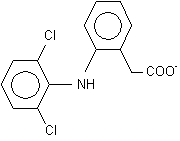Definition
Nonsteroidal antiinflammatory drugs (NSAIDs) reduce pain and inflammation.
Purpose
NSAIDs often are used to relieve mild to moderate pain for all types of cancer.
Description
This class of drugs eases discomfort by blocking the pathway of an enzyme that creates prostaglandins (hormones that cause pain and swelling). By doing so, the drugs lessen the pain in different parts of the body.
Some of the NSAIDs used in cancer treatment include: ibuprofen (Motrin, Advil, Rufen, Nuprin), naproxen (Naprosyn, Naprelan, Anaprox, Aleve), nabumetone (Relafen), ketorolac, sulindac and diclofenac (Cataflam, Voltaren). The class of drugs known as Cyclooxygenase-2 inhibitors that emerged in the late 1990s for dealing with arthritis pain, such as the brand names Celebrex and Vioxx, is also considered part of the group of NSAIDS.
If NSAIDs are not strong enough to keep a cancer patient comfortable, physicians often will combine them with opioids, such as codeine. In later stages, doctors also may combine NSAIDs with stronger pain killers, such as morphine, to treat very severe pain.
NSAIDs also may be used to prevent colon cancer and other types of cancer, although scientists are still studying this experimental approach (see entry on chemoprevention).
Recommended dosage
Patients typically take NSAIDs on an as-needed basis. Doses vary depending on the type of NSAID being used. For example, the most common type, ibuprofen, is available over the counter in 200mg caplets, which can be taken at regular intervals throughout the day. The maximum daily dose for ibuprofen is 1,200 mgs.
Precautions
Most doctors recommend taking NSAIDs with a full glass of water. Avoid taking these drugs on an empty stomach. Smoking cigarettes and drinking alcohol while taking NSAIDs may irritate the stomach.
People who take NSAIDs should notify their doctor before having surgery or dental work, since these drugs can prevent wounds from healing properly.
Women who are pregnant or breastfeeding should check with their doctor before taking NSAIDs, because they may be harmful to a developing fetus or a newborn.
Diabetics, people who take aspirin, blood thinners, blood pressure medications or steroids also should check with their doctor before taking NSAIDs.
Side effects
Many NSAID users experience mild side effects, such as an upset stomach. In 4 to 7% of cases, more serious complications develop, such as stomach ulcers. Typically, elderly people experience the most serious complications.
Common side effects include stomach upset, constipation, dizziness and headaches.
More severe side effects include stomach ulcers and bleeding ulcers. If a person has black, tarry stools or starts vomiting blood, it may be caused by a bleeding ulcer.
Kidney dysfunction is another severe complication of long-term NSAID use. Signs of kidney problems include dark yellow, brown or bloody urine. NSAID use also may cause liver function problems over longer periods of time.
To guard against ulcers, physicians may ask patients to take NSAIDs with anti-ulcer medication, such as omeprazole or misoprostol. Another option is to take the NSAID in a different, non-oral form. Often topical creams or suppositories are available. Finally, doctors may decide to switch to a different pain killer, such as a cyclooxygenase-2 inhibitor like Celebrex or codeine, which would be easier on the stomach.
Interactions
NSAIDs can be taken with most other prescription and over-the-counter drugs without any harmful interactions. Certain drug combinations, however, should be avoided. For instance, when ibuprofen is combined with methotrexate (used for chemotherapy and arthritis treatment) or certain diabetic medicines and anti-depressants, it can amplify negative side effects. Patients should check with a pharmacist before taking NSAIDs with other drugs.
KEY TERMS
- Cyclooxygenase-2 inhibitor
- A type of drug, such as Celebrex, that reduces pain and inflammation. Also called a COX-2 inhibitor.
- Enzyme
- A protein that speeds the chemical reactions in the body.
- NSAIDs
- Nonsteroidal antiinflammatory drugs (NSAIDs) reduce pain, fever and swelling.
- Opioids
- A class of pain-killing drugs, including codeine.
- Prostaglandins
- Hormones that cause pain and swelling in the body.



